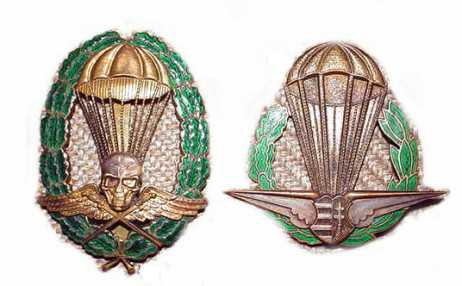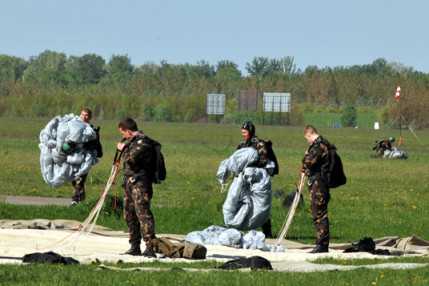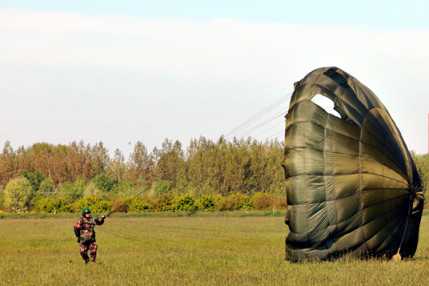Who Descend From The Sky With A Parachute
Szöveg: László Szűcs | 2009. március 31. 6:32One desires to pull away from the ground, fly free, and return safely. Humankind has always wanted to fly and also to overcome depths safely. Although in China there were some attempts to construct structures creating an aerodynamic drag as early as the 1300s, but the ’big jump’ remained to be a dream for centuries.
The first important date on the long road leading to the development of the parachute we know today was 1767, when man descended to the ground for the first time – with the help of ’dead material’ – from an altitude which would have been lethal by all means, provided he had chosen to jump instead. Later the development of parachuting was given an impetus in the era of ballooning, but it evolved fully only with the spreading of military aviation. The first successful parachute jump from an aircraft was conducted in 1912 by Albert Berry, a pilot.
For decades, it has been a tradition in the Hungarian Defence Forces to remember the paratroopers on March 23, because in 1918, Lieutenant Antal Boksay made his first successful parachute jump on this day.
The history of Hungarian military parachuting
The idea of parachuting came up in the Hungarian military 72 years ago, in the first half of 1937, when the Royal Hungarian Ministry of Defence intensively begun to deal with the establishment of new corps. Based on a foreign example, they were examining the establishment of granade teams in the first place, for they wanted to have a combat unit in place which was capable of carrying out even the most difficult combat tasks. According to the concept of the period, mobility was an important element in the regular operation of such corps. And to obtain the required level of mobility, the parachute jump conducted following air transport seemed to be the best solution.
In the circles of the Hungarian military command the concept of setting up a paratrooper unit outlined by 1938. In July, the Ministry of Defence circulated a letter informing the commanders of the corps about the establishment of a Hungarian military paratrooper unit and asked for young, volunteering officers for its future corps. Captain Árpád Bertalan, who also participated in the elaboration of the organizational and deployment principles of grenade teams, became the commander of the corps. They started their training on August 25, and conducted the first jumps – following acclimation flights – on September 2.
Following that, as of October 1, 1939, the first paratrooper company of the armed forces was established, and was stationed at the Pápa hussar barracks and the airport. Later the division was reorganized into a battalion. After the continuous fill-up of personnel, in the last days of August 1940, Royal Hungarian 1st Paratrooper Battalion was established – with three companies.

They did not have to wait for long for the first live mission either, since when on April 6, 1941 German troops crossed the border of Yugoslavia, they were also counting on the support of Hungarian troops. In the attack that was launched at 2.00 pm on April 11, 1941 they had been calculating with the deployment of the first Hungarian paratrooper battalion as well – the plan was that paratroopers launched a surprise attack and occupied an important bridge over Franz-Joseph channel in the Bácska-region, and retained it until their own troops arrived, because the high military command believed that withdrawing Yugoslavian troops would blow up the bridge. Almost 200 paratroopers were selected for the planned mission and started their target-oriented preparations. Of course, the first deployment was followed by more. For example, they were present in the Carpathians in 1942, but they had also been deployed several times with the aim of making it more difficult for the Soviets to launch attacks.
After the world war
Following the end of the Second World War, between 1945–1948 the Hungarian military did not have a paratrooper corps. However in 1948, the political and military leadership decided on a large-scale military development scheme. In the framework of the scheme the Chief of the MoD Defence Staff at the time, Lieutenant General László Sólyom regarded the reorganization of the paratrooper service necessary. For this purpose, he ordered the establishment of a training panel from those officers and non-commissioned paratrooper officers who were in Hungary and were eligible. The next significant date is March 1, 1949, when the First Honvéd Independent Paratrooper Battalion was established. It did not exist for long, since as early as September, it merged with the Tapolca rifle regiment and became its first battalion. Almost at the same time, in June 1949, and in Tapolca again, the Paratrooper Training School was founded.
Two years later, the battalion became independent once more and moved to Székesfehérvár, bearing the new name of 62nd Independent Paratrooper Battalion. As the superiors pointed out, their function following their transportation by air was to fight in the background territories of the enemy.
The biggest paratrooper exercises of the Hungarian People’s Army, conducted on October 18, 1952 near the village of Csór, are related to this battalion. The aircraft were taking off from Szolnok, the length of the formation was two and a half kilometers. Precise implementation turned out to be more difficult due to a minor technical problem, but on the whole, the exercises went well. But the division paid a big price for achieving the target. One of the troops, Lieutenant Mihály Juhász landed dead. The post-mortem examination found that a ripcord slit his throat.
Unfortunately, this battalion could not avoid closing down either, which had to be completed by November 30, 1954.
The development of the paratrooper service of the air force
After 1945, in the framework of the democratic air force the maintenance of the parachutes of the few aircraft that remained was not problematic until October 1948. But the training of aviation officers, the establishment of the first wing, and the nearly 150 aircraft entering service created a new situation in this field as well. Since paratrooper training was in its syllabus, Kilián György Flight Officers’ School was the first where a paratrooper group was organized. This small team, and the few enlisted troops who were added to them, formed the basis of the paratrooper services that followed.
The paratrooper services of the air force saw significant development with the transfer of the jet-propelled aircraft technology that arrived to Hungary in 1951, because the MiG–15 aircraft, which also had ejection seats, came with parachutes that required special handling. In addition to that, the duties of the services also included trainings on the use of rescue equipments, the execution of ejections, as well as organizing and conducting training jumps – which had been an unusual task until then – and the specialized training and advanced training of the airborne crew. The extensive professional theoretical and practical knowledge of the members of the paratrooper service primarily included the provision of service for flights, testing the related technical equipments and incorporating them into the system.
The tasks of the paratrooper services of the airborne troops have always been modified as a result of advancing technologies. Besides the parachute and rescue equipment training of the airborne crew and serving flights with parachutes and drogue chutes, setting up a search–rescue service has been introduced as a new element.
The new beginning…
With the appearance of weapons of mass destruction on front, army, and division-level it has been clear for senior military leaders from the second half of the ‘50s that a special reconnaissance organization has to be set up, which, in a given case, is able to provide military commanders with data from great depths on the whereabouts, condition, readiness of these weapons and, provided no other instruments are available, delay their use with the help of special forces in order to protect our troops.

They envisaged the new organization in the form of a company and started the arrangements according in line with that. With the establishment of the division they were aiming at adding a new reconnaissance service, deep reconnaissance, to the reconnaissance corps. The new reconnaissance division was set up on December 1, 1959, and its first station was Ságvári Endre barracks in the capital.
The extension of deep reconnaissance organizations with paratrooper capabilities took place between 1963 and 1977. In this period, independent deep reconnaissance battalions were established along with the deep reconnaissance companies of reconnaissance battalions. The continuity and uniformity of paratrooper training was the result of joint sessions, which were organized two times a year and lasted for one month respectively, with the participation of 80–100 paratroopers at a time.
Military parachutists today
Giving an exact overview of the changes in the reconnaissance corps and the paratrooper ’profession’ is not what this article should aim at, naturally. Nevertheless, it must be mentioned that today there is not an independent reconnaissance corps that would have the word ’reconnaissance’ in its name. Of the ’last two’, HDF 34th ’László Bercsényi’ Reconnaissance Battalion of Szolnok has been reorganized and obtained a new capacity, working as a special operations battalion at the moment. HDF 24th ’Gergely Bornemissza’ Reconnaissance Battalion has become a part of ’István Bocskai’ Infantry Brigade of Eger.
Of course, the paratrooper capability continues to be one of the key capabilities of the Hungarian Defence Forces. Currently there are paratrooper positions at HDF 34th Special Operations Battalion of Szolnok, 25/88th Light Mixed Battalion stationed in the same town, and at the 5/24th Reconnaissance Battalion of Debrecen. Moreover, there are paratroopers serving at the corps operating the military airports, that is at Kecskemét’s HDF 59th ’Dezsõ Szentgyörgyi’ Aviation Base, HDF 86th Szolnok Helicopter Base, and HDF Pápa Base Airport. In total, there are several hundred paratroopers.

Four out of several hundred…
Honvedelem.hu has recently interviewed four non-commissioned officers serving as paratroopers. The guys are from HDF 5/24th ’Gergely Bornemissza’ Reconnaissance Battalion of Debrecen-based HDF 5th ’István Bocskai’ Infantry Brigade and by the time this article is published, they will be serving in Afghanistan in the sixth troop rotation of the Hungarian Provincial Reconstruction Team.
Staff Sergeant Ferenc Munkácsi is the deep reconnaissance squad commander of his battalion. As he said: at the moment he is the one with the highest number of parachute jumps at the corps, to be absolutely specific, there are 265 jumps ‘behind his back’. Half of them are so-called static line jumps and half of them are freefall jumps.
The staff sergeant told us that static line jump is the simplest and most frequent jump. In short, after the jumper has left the aircraft the main canopy is opened by the so-called static line which is hooked on to the cable inside the aircraft. Low jump altitude and the use of a round parachute allowing fast opening are typical of static line jumps.Freefall or hand-deployed jump on the other hand is less used in practice and is a more complex method that has two absolutely different types.
One is the so-called HALO jump (High Altitude Low Opening), during which leaving the aircraft takes place at a high altitude – even above 10,000 meters – and after ’falling’ for the right amount of time the parachutists open their main canopies themselves at a low but still safe altitude.
The other type of military freefall jumps is he so-called HAHO jump (High Altitude High Opening), which means that parachutists open their main ram air parachute soon after they have jumped out of the aircraft at a high altitude and by using its ability to act like a glider and fly longer distances without making a sound, they can fly a considerable horizontal distance, even 40–50 kilometers towards the target area.
– Those who begin paratrooper training have to make 12 static line jumps after completing the ground preparations. Following that, in two or three years’ time they will reach the level and are safe enough in the air to be able to conduct freefall jumps. But another training is required for this – said Ferenc Munkácsi.
The staff sergeant also told us that fortunately, they could complete the major part of the planned jumps in 2008, in other words the paratrooper crew in basic training made 17 jumps, and those with freefall, instructors’ and assistant instructors’ qualifications conducted 52 jumps.
– Everyone has a ’worst jump’. This dividing line comes at different times for everyone. For me, the fifth and the sixty-seventh jumps were such points. The latter because it was my first freefall jump. But the one I was the most concerned about was my first jump, made from an AN-26. Fortunately, I landed without any problem – remembered Staff Sgt. Munkácsi, who decided to be a paratrooper in 1995, when he was enlisted. True, he had to tell a lie to get this position. He told a fib that he had jumped before, but it wasn’t true…
Staff Sergeant Tibor Nagy is the group commander of the deep reconnaissance company of the 5/24th battalion. So far he has only 17 jumps, which means that he completed basic training just a few months ago. As he said: after the successful completion of the ground training it was very difficult to stand in the door of the helicopter for the first time, and realize that he has to jump now. On such occasions the team spirit also makes one to go ahead, because all the others are standing behind him and waiting to step out into nothing.
– I have been a soldier since 2003, but I always wanted to be a paratrooper. Since from the reconnaissance troops the paratroopers excel. In my opinion this is the peak of the profession. But I had the chance to make my dreams come true only when the corps were relocated from Eger to Debrecen, and we got back the paratrooper capability – said Staff Sgt. Nagy, whose worst jump was the first one, for his landing went wrong and his leg was hurting for weeks.
Corporal László Pócs, the target-marker of the second deep reconnaissance group of the reconnaissance company, had 130 jumps so far; he has been a paratrooper for 10 years. He started his freefall training this year and completed it successfully, his last 30 jumps were manually deployed. According to him, anyone who is only a bit ’into’ parachuting will say that freefall jumps are much better.
– In 1999, when I was enlisted, I could choose if I wanted to be a cook or a paratrooper. Since I did not want to choose the same profession in the military as in private life, I took up parachuting. I liked it very much and after I was discharged I stayed in the army as a paratrooper – said the corporal, in the opinion of whom the first ‘dividing’ point comes in the life of paratroopers when they suddenly realize that what they are doing is dangerous and they can even die. The first freefall jump and the first real emergency are also similar ‘dividing lines’.
László Pócs has already experienced an emergency: after jumping out of the aircraft his pilot parachute got entangled between his legs. He solved the situation instinctively, relying on what he had learnt in basic training. As he put it: his mind switched off almost completely, and was mechanically doing what needs to be done in a situation like that. Fortunately, he managed to shake the pilot parachute off of his leg and did not need the emergency parachute, even though his hand was already on the ripcord. He had the time to be frightened only after he landed successfully.
Corporal Viktor Vavrek is a paratrooper/diver of the second deep reconnaissance platoon, which means that in addition to parachuting, he is also a diver. He completed the military parachuting basic training in February 2002, and earned his divers’ qualifications a few months ago.
– Before joining the service, I worked in the construction industry a lot, and since I was not afraid of heights, I thought I would try what it feels like to jump from an aircraft. There are no words to describe that, I can only recommend it to everyone – said the young junior non-commissioned officer, who has 113 jumps so far and he even completed the freefall training this year.
(The source of the historical part of the article was the university coursebook titled Military Parachuting in Hungary, published by Zrínyi Miklós University of National Defence.)